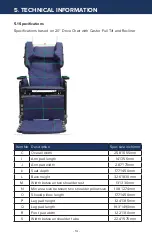
- 13 -
4. INSPECTION AND FUNCTIONAL TESTING
Safety measures as described in Section 1 must be observed when inspecting
or testing a chair. Only authorized caregivers or maintenance staff should
attempt to inspect or test a chair.
4.1 Inspection
W
e recommend regular visual inspection for signs of wear, damage, loose
or missing fittings, and other safety concerns. If a breakage, defect, or
operational problem is detected, the chair must be repaired inspected and
tested for function before it is returned to service.
W
e recommend that the chair be inspected as often as each use if there
is any reason to be concerned about the possibility of increased wear or
loose or missing fittings.
At a minimum, in regular use the chair should be
inspected on a bimonthly basis.
The visual inspection procedure should
include at least the observation of all the fittings (fasteners):
T
he visual inspection procedure should include at least the observation of
the following parts:
1.
The cylinders that position the seat tilt, back recline, and independent
leg rest elevation.
2. The vinyl straps used in the seat, back, leg rest, footrest and wings
3. The cushions
4. The black handles and cables.
5. The armrest height adjustment pins
T
he visual inspection procedure should include the observation of any
installed accessories. The visual inspection should be performed by the
facility, or if in a private residence, by the individual responsible for the chair.
4.2 Functional Testing
We recommend that the chair should be tested for operation of the chair’s
functions without a resident in the chair.
The testing may be as often as each
use if there is any reason to be concerned about the possibility of increased
wear or damage to the chair’s components. At a minimum, in regular use the
chair should be tested for functions as described in Section 3.
If
the caregiver or maintenance department performing the functional
testing believes that any function is not operating correctly, the chair should
be taken out of service until a satisfactory functional test can be completed.
The caregiver or maintenance department performing the testing should
be aware that the seat tilt, back recline, and footrest (leg rest) elevation
operations will be more difficult without a resident in the chair.
W
hen performing repairs or maintenance, do not use lubricants that contain
solvents. Solvents will damage many of the moving components in the chair.
If necessary, a white, food grade grease (lubricant) may be used on the
sliding components in the chair. Do not use spray lubricants on any part of
the chair.






































